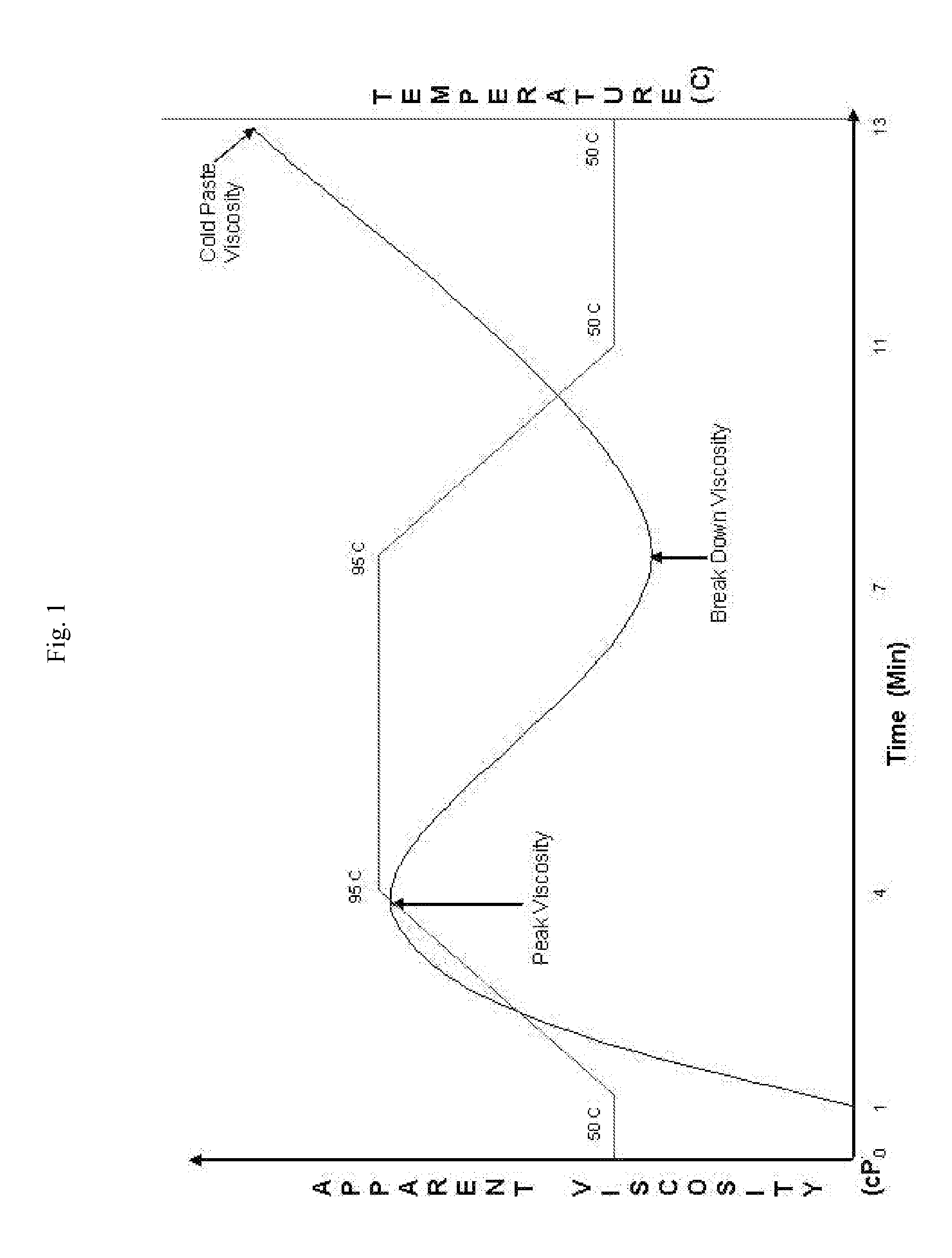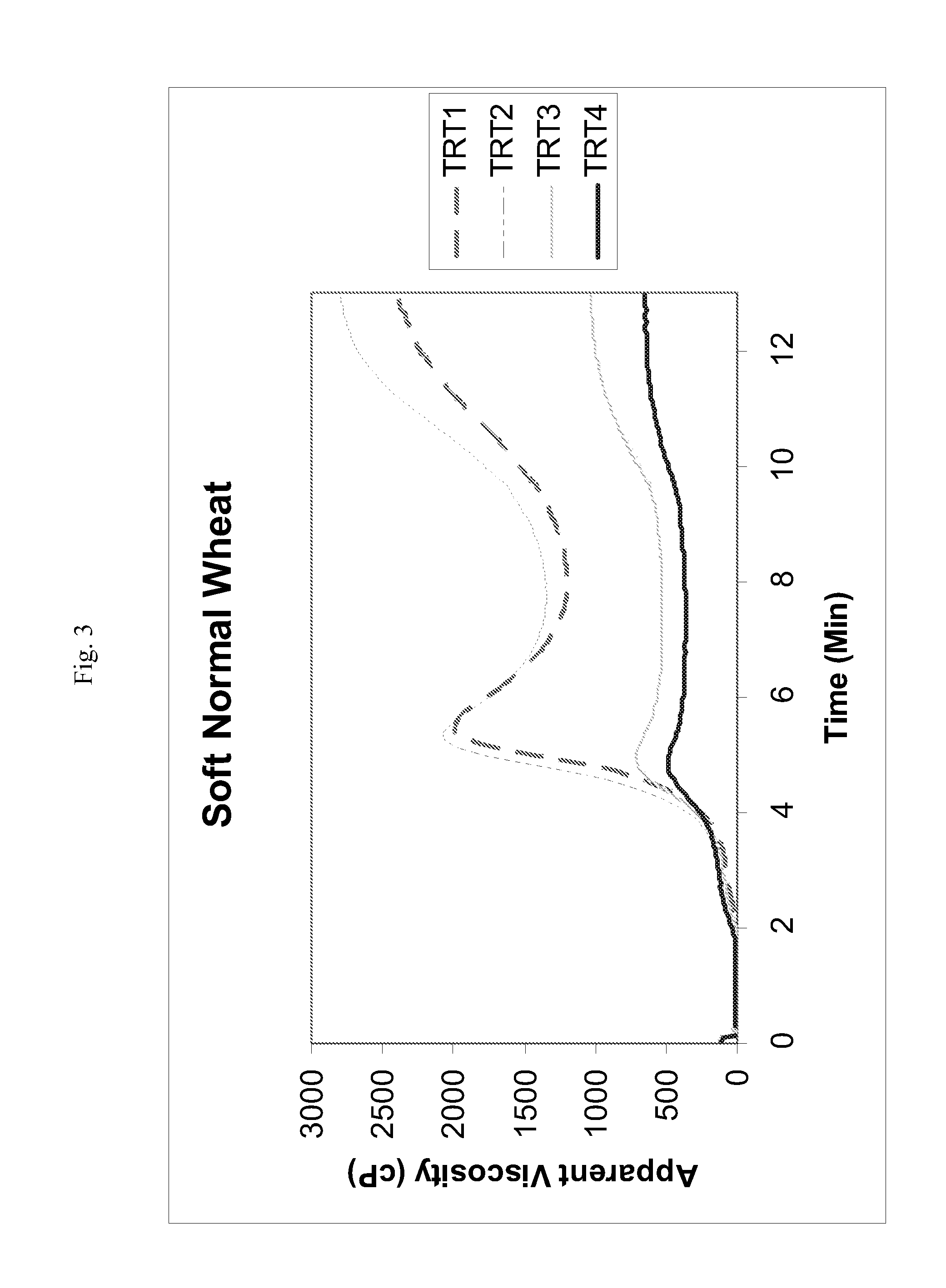Non-cohesive waxy flours and method of preparation
a waxy flour and non-cohesive technology, applied in the field of non-cohesive waxy flours and methods of preparation, can solve the problems of waxy flour showing a significant breakdown in viscosity and unsatisfactory, and achieve the effect of increasing moisture conten
- Summary
- Abstract
- Description
- Claims
- Application Information
AI Technical Summary
Benefits of technology
Problems solved by technology
Method used
Image
Examples
experiment 1
sting Properties of Different Flours
[0056]Pasting properties of HNW, HWW, SNW and SWW were determined by RVA. An overlaid graph of pasting curves of different flours can be seen in FIG. 2 and pasting properties are given in Table 1. The peak viscosity of SWW flour was higher than that of SNW and HNW flours. Additionally, peak viscosity for SWW flour was observed earlier, at 3.3 min, whereas peak viscosity for SNW and HNW was found at 5.6 min. The hot paste viscosity of SWW flour was lower than that of SNW and HNW flours. The cold paste viscosity for SWW flour was significantly lower as compared to SNW and HNW flours. Large breakdown in viscosity was observed for waxy wheal flours and the cooks of waxy wheat flours exhibited cohesive textures.
TABLE 1Pasting properties of different curves at 10% solids.Sample / PeakHot PasteCold PastePropertyViscosityViscosityBreak DownViscositySet BackSNW2107122288524731252HNW2167124991825381289SWW233877715611086309HWW199569712981007310
experiment 2
ating on Different Flours
[0057]The wheat flour samples were subjected to various heating profiles. Flours (15 g each) were evenly spread onto a plate and heated in an oven. The heating profile included heating the sample at 105° C. for 30 min followed by increasing the temperature of the oven to 165±3° C. The plates were drawn out at regular intervals as described in each individual experiment.[0058]Each of the four flours i.e. SNW, HNW, SWW and HWW, was subjected to four different heat treatments.[0059]Treatment 1 (TRT1): 105° C. for 30 min[0060]Treatment 2 (TRT2): 105° C. for 30 min and additional time till the oven reached the temperature of 165±3° C.[0061]Treatment 3 (TRT3): 105° C. for 30 min and an additional 10 min at 165±3° C.[0062]Treatment 4 (TRT4): 105° C. for 30 min and an additional 30 min at 165±3° C.[0063]The flours were then cooled to room temperature over a period of 18 hours. The samples were then analyzed for their pasting properties using an RVA. Pasting curves a...
experiment 3
nt of Hard Waxy Wheat Flour—Open Conditions
[0065]Hard winter waxy wheat flours (15 g each) were evenly spread onto a plate and heated at 105° C. for 30 minutes and then the oven temperature was increased to 165° C. and the flours were held for 0, 15, 30, or 60 minutes. The pasting curves (10% solids, neutral pH) of heat treated samples and un-treated hard waxy wheat flour were shown below. Heat treated hard waxy wheat flours had higher viscosity than the un-treated hard waxy wheat flour (control). (FIG. 9) Viscosity breakdown was reduced after heat treatment (165° C., 30 min) and the cook was non-cohesive. After RVA measurements, the cooked waxy wheat flours were stored in a refrigerator. After 3 weeks of storage, no syneresis was observed, indicating that the heat treated waxy wheal flours had good cold storage stability.
PUM
 Login to View More
Login to View More Abstract
Description
Claims
Application Information
 Login to View More
Login to View More - R&D
- Intellectual Property
- Life Sciences
- Materials
- Tech Scout
- Unparalleled Data Quality
- Higher Quality Content
- 60% Fewer Hallucinations
Browse by: Latest US Patents, China's latest patents, Technical Efficacy Thesaurus, Application Domain, Technology Topic, Popular Technical Reports.
© 2025 PatSnap. All rights reserved.Legal|Privacy policy|Modern Slavery Act Transparency Statement|Sitemap|About US| Contact US: help@patsnap.com



